

@cpoyatos – Pyrox.es – Just another WordPress site. Entorno Personales de Aprendizaje. YouTube. Del PLE al MOOC. Hacia la construcción de una metodología para el estudio de las `Comunidades Virtuales´. Una propuesta emergente. Archivo OCS Hacia la construcción de una metodología para el estudio de las `Comunidades Virtuales´.
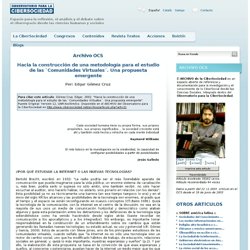
Una propuesta emergente Por: Edgar Gómez Cruz : Gómez Cruz, Edgar, 2002, "Hacia la construcción de una metodología para el estudio de las `Comunidades Virtuales´. Una propuesta emergente". Cada sociedad humana tiene su propia forma, sus propios propósitos, sus propios significados....la sociedad creciente está ahí y también está hecha y rehecha en cada mente individual El reto básico en la investigación es la creatividad, la capacidad de configurar posibilidades a partir de posibilidades ¿Por qué estudiar la internet o las nuevas tecnologías? El largo camino hacia las TIC. En los últimos años dentro de las tareas de formación con el profesorado un tema estrella es la introducción de las TIC en las aulas, la integración con los contenidos de la materia y su utilización como herramienta de aprendizaje.
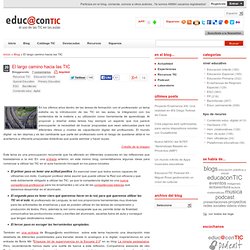
Al proponer y diseñar estas tareas hay siempre un aspecto que nos parece preocupante: la necesidad de buscar propuestas que sean adecuadas para los diferentes ritmos y niveles de capacitación digital del profesorado. El mundo digital va tan deprisa y es tan cambiante que parte del profesorado corre el riesgo de quedarse atrás si no acertamos a ofrecerle propuestas didácticas que pueda asimilar y hacer suyas. Diseño de un PLE para el aula en un entorno de Escuela 2.0. 6.1.3. Aprendizaje para todos, por todos y acerca de casi todo. Social learning theory. Is a perspective that states that people learn within a social context.
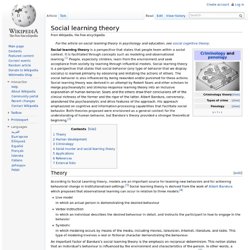
It is facilitated through concepts such as modeling and observational learning. [ 1 ] [ edit ] Theory According to Social Learning theory, models are an important source for learning new behaviors and for achieving behavioral change in institutionalized settings. [ 2 ] Social learning theory is derived from the work of Albert Bandura which proposed that observational learning can occur in relation to three models: [ 3 ] • Live model – in which an actual person is demonstrating the desired behaviour • Verbal instruction – in which an individual describes the desired behaviour in detail, and instructs the participant in how to engage in the behavior • Symbolic – in which modeling occurs by means of the media, including movies, television, Internet, literature, and radio.
An important factor of Bandura’s social learning theory is the emphasis on reciprocal determinism. 1. 2. 3. 4. Situated learning. Situated learning was first proposed by Jean Lave and Etienne Wenger as a model of learning in a community of practice.
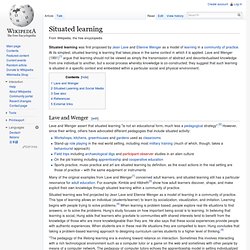
At its simplest, situated learning is learning that takes place in the same context in which it is applied. Lave and Wenger (1991)[1] argue that learning should not be viewed as simply the transmission of abstract and decontextualised knowledge from one individual to another, but a social process whereby knowledge is co-constructed; they suggest that such learning is situated in a specific context and embedded within a particular social and physical environment. Lave and Wenger[edit] Lave and Wenger assert that situated learning "is not an educational form, much less a pedagogical strategy".[2] However, since their writing, others have advocated different pedagogies that include situated activity: Many of the original examples from Lave and Wenger[1] concerned adult learners, and situated learning still has a particular resonance for adult education. Virtual learning environment. A virtual learning environment (VLE), or learning platform, is an e-learning education system based on the web that models conventional in-person education by providing equivalent virtual access to classes, class content, tests, homework, grades, assessments, and other external resources such as academic or museum website links.
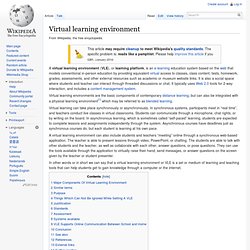
It is also a social space where students and teacher can interact through threaded discussions or chat. It typically uses Web 2.0 tools for 2-way interaction, and includes a content management system. Virtual learning environments are the basic components of contemporary distance learning, but can also be integrated with a physical learning environment[1] which may be referred to as blended learning. Virtual learning can take place synchronously or asynchronously. In synchronous systems, participants meet in “real time”, and teachers conduct live classes in virtual classrooms. Major Components Of Virtual Learning Environment[edit] Similar terms[edit] Personal learning environment.
Personal Learning Environments (PLE) are systems that help learners take control of and manage their own learning.[1] This includes providing support for learners to: Set their own learning goals.Manage their learning, both content and process.Communicate with others in the process of learning.

A PLE represents the integration of a number of "Web 2.0" technologies like blogs, Wikis, RSS feeds, Twitter, Facebook, etc. around the independent learner. Using the term "e-learning 2.0", Stephen Downes describes the PLE as: "... one node in a web of content, connected to other nodes and content creation services used by other students. It becomes, not an institutional or corporate application, but a personal learning center, where content is reused and remixed according to the student's own needs and interests. Entornos personales de aprendizaje (PLE)